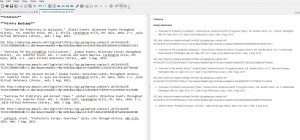What do you value? [
I’ve had an itch all weekend long I couldn’t scratch until this morning. Session after digital humanities session highlighted the possibilities offered by new (mostly software) tools for understanding our world. Questions that might once have been improbably hard to answer (how often does a historical figure mention the ten cities closest to her home city in a work of 10,000 words) can no be dispatched with the flick of mouse. Particularly impressive have been the the two ends of the spectrum, field defining scholarship and more limited yet nonetheless fascinating undergraduate projects.
Yet, for all the brilliance of the technology, methodology, and–at times–andragogy of the presentations, I missed something. Rather, I saw it in asides, tangents, dry humor, and apologetic caveats: why does DH matter? I heard about the ability to access knowledge in new ways (digital vs analog, dynamic vs. static), new ways of analyzing established sources (distant reading, GIS, computer mediated transcription), and new ways of displaying existing information (student exhibits, DH research websites), but I didn’t hear a lot of why are we doing this.
Yes, we can. We can plot locations, parse data, and generally code the sum of human of existence into submission, making it bow to our technological prowess. Should we, and if so how should we? What do we value, as individuals, as educators, as scholars, as community members? One participant asked why I taught DH at the survey level and I said to get my students jobs. And while that was honest, I didn’t highlight the value behind that answer, that skilled paid work gives students options for a better life. Like you, I want to improve my students’ lives. And I don’t want to hide that, nor should you.
If you teach DH because you want to make the world a better place, say just that. If you don’t care about the world and just want to advance your career, say that. If you’re a nihilist who believes DH is just as useless as any other pursuit so why not do it rather than bake bagels, say that.
My point isn’t to superimpose my values on other’s andragogy, only to call for greater attention to the values embedded, explicitly and implicitly, in our DH work. As Vance Ricks, a philosophy professor at Guilford College, noted to me during a coffee break, if we fail to articulate our own values, the values of our work will be shaped by others. Knowledge creation is not neutral, even if combinations of 0 and 1s appear so.
To give relief to these general musings, consider the use of GIS to chart the ancient world. Some of the most prominent projects take well-know texts and geolocate references in the texts. In short, take famous text (Herodutus) add GIS and stir. It’s fantastic, truly. At the same time, historians have worked for half a century to expand what we know about the past beyond the elites that created most of our primary sources. For example, understanding women in ancient Greece requires reading “across the grain,” looking for the gender dynamics of ancient Greece in close readings of texts that are references against scant other sources, such as art, poetry or financial records. In short, our source record speaks directly to the immediate experience of maybe 5% of the ancient Greek world and historians have found creative ways to learn more about the other 95%.
If we go back and simply apply DH tools to existing sources, we risk reproducing the blindspots of historians 50 years ago. Or worse, we risk re-articulating the value that only the elite males of the past made history worth studying. As I reconsider my thoughts, I think it important to distinguish between undergraduate projects–which should be first to teach and second to advance scholarship–and more advanced work–which should know better.
I also want to acknowledge the folks I saw who presented work that both “liberates data” and “liberates people.” Matthew Cisk is working on mapping the South Bend community so that the city and the community can improve their neighborhoods. Sabina Deitrick and Abigael Wolensky went into Homestead and West Homestead and worked to make digital technology serve the people of those communities. And many people shared stories with me about how important using DH to improve society was to them. Miriam Neptune noted that technology can separate or unite students of color with their classmates, depending on how its deployed. I am hopeful these efforts continue, even flourish.
That’s a lot of words for this idea: why do you do DH?

